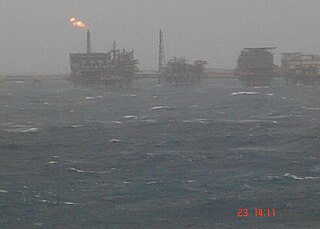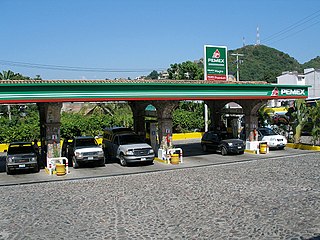Notes
This section is empty.You can help by adding to it.(July 2010) |
This page summarizes projects that propose to bring more than 20,000 barrels per day (3,200 m3/d) of new liquid fuel capacity to market with the first production of fuel beginning in 2020. This is part of the Wikipedia summary of Oil Megaprojects.
| Overview | 2003 | 2004 | 2005 | 2006 | 2007 | 2008 | 2009 | 2010 | 2011 | 2012 | 2013 | 2014 | 2015 | 2016 | 2017 | 2018 | 2019 | 2020 |
| Country | Project Name | Year startup | Operator | Area | Type | Grade | 2P resvs | GOR | Peak Year | Peak | Discovery | Capital Inv. | Notes | Ref |
|---|---|---|---|---|---|---|---|---|---|---|---|---|---|---|
| OPEC | ||||||||||||||
| Kuwait | Project Kuwait Phase II | 2020 | KOC | LAND | Crude | Heavy | 2020 | 0 | No FID 400 kbd | [1] [2] | ||||
| Iran | Yadavaran Ph 2 | 2020 | Sinopec | LAND | Crude | Heavy | 3.20 | 100 | 2000 | [3] | ||||
| Saudi Arabia | Berri Exp | 2020 | Saudi Aramco | LAND | Crude | Extra Light | 0 | No FID 300 kbd | [4] | |||||
| Saudi Arabia | Khurais Exp | 2020 | Saudi Aramco | LAND | Crude | Light | 0 | No FID 300 kbd | [4] | |||||
| Saudi Arabia | Safaniyah Exp | 2020 | Saudi Aramco | OFF | Crude | Heavy | 0 | No FID 700 kbd | [4] | |||||
| Saudi Arabia | Zuluf Exp | 2020 | Saudi Aramco | OFF | Crude | Medium | 0 | No FID 900 kbd | [4] | |||||
| Non-OPEC | ||||||||||||||
| Canada | Joslyn Ph 4 | 2020 | CNRL | LAND | Bitumen | Oil sands | 0 | Application No FID 50 kbd | [5] | |||||
| Mexico | (Chicontepec) Exp 3 | 2020 | PEMEX | LAND | Heavy | 2.287 | 2024 | 200 | $30B | [6] [7] [8] | ||||
| United States | (Eagle Ford Shale) | 2020 | Chesapeake Energy | LAND | Crude | Light | 2020 | 500 | 2010 | JV with CNOOC | [9] | |||
This section is empty.You can help by adding to it.(July 2010) |

Petróleos Mexicanos, which translates to Mexican Petroleum, but is trademarked and better known as Pemex, is the Mexican state-owned petroleum company, created in 1938 by nationalization or expropriation of all private, foreign, and domestic oil companies at that time. Pemex had total assets worth $415.75 billion, and was the world's second-largest non-publicly listed company by total market value, and Latin America's second-largest enterprise by annual revenue as of 2009, surpassed only by Petrobras. The majority of its shares are not listed publicly and are under control of the Mexican government, with the value of its publicly listed shares totaling $202 billion in 2010, representing approximately one quarter of the company's total net worth.
The Chicontepec Basin is a petroleum system in Mexico north-east of Mexico City, covering an area of around 3,800 square kilometres (1,500 sq mi) in the states of Veracruz, Puebla and Hidalgo. Several oil fields have been discovered in that area since 1926. A major field was discovered in 1973 but contains extra heavy crude, which due to special refining needs is considered unviable at this time. Since that time, tiny amounts of oil have been produced. While the reserves are overwhelmingly extra heavy crude, pockets of lighter tight oil, as well as natural gas, are also found in the basin.

Cantarell Field or Cantarell Complex is an aging supergiant oil field in Mexico. It was discovered in 1976 after oil stains were noticed by a fisherman, Rudesindo Cantarell Jimenez, in 1972. It was placed on nitrogen injection in 2000, and production peaked at 2.1 million barrels per day (330,000 m3/d) in 2004. In terms of cumulative production to date, it is by far the largest oil field in Mexico, and one of the largest in the world. However, production has declined since 2004, falling to 408,000 barrels per day (64,900 m3/d) in April 2012, making it Mexico's second fastest production rate oil field after Ku-Maloob-Zaap.

Peak oil is the theorized point in time when the maximum rate of extraction of petroleum is reached, after which it is expected to enter terminal decline. Peak oil theory is based on the observed rise, peak, fall, and depletion of aggregate production rate in oil fields over time. It is often confused with oil depletion; however, whereas depletion refers to a period of falling reserves and supply, peak oil refers to the point of maximum production. The concept of peak oil is often credited to geologist M. King Hubbert whose 1956 paper first presented a formal theory.

From the mid-1980s to September 2003, the inflation-adjusted price of a barrel of crude oil on NYMEX was generally under US$25/barrel. During 2003, the price rose above $30, reached $60 by 11 August 2005, and peaked at $147.30 in July 2008. Commentators attributed these price increases to many factors, including Middle East tension, soaring demand from China, the falling value of the U.S. dollar, reports showing a decline in petroleum reserves, worries over peak oil, and financial speculation.
Oil shale economics deals with the economic feasibility of oil shale extraction and processing. Although usually oil shale economics is understood as shale oil extraction economics, the wider approach evaluates usage of oil shale as whole, including for the oil-shale-fired power generation and production of by-products during retorting or shale oil upgrading processes.
Energy in Mexico describes energy and electricity production, consumption and import in Mexico. Electricity sector in Mexico is the main article of electricity in Mexico.
This page summarizes projects that brought more than 20,000 barrels per day (3,200 m3/d) of new liquid fuel capacity to market with the first production of fuel beginning in 2005. This is part of the Wikipedia summary of Oil Megaprojects—see that page for further details. 2005 saw 23 projects come on stream with an aggregate capacity of 3.951 million barrels per day (628,200 m3/d) when full production was reached.
This page summarizes projects that brought more than 20,000 barrels per day (3,200 m3/d) of new liquid fuel capacity to market with the first production of fuel beginning in 2006. This is part of the Wikipedia summary of Oil Megaprojects. 2006 saw 30 projects come on stream with an aggregate capacity of 4.092 million barrels per day (650,600 m3/d) when full production was reached this list does not like include any of the enormous project developed in the United states which dwarf these by +-5000 BOE.
This page summarizes projects that brought more than 20,000 barrels per day (3,200 m3/d) of new liquid fuel capacity to market with the first production of fuel beginning in 2007. This is part of the Wikipedia summary of Oil Megaprojects.
This page summarizes projects that brought more than 20,000 barrels per day (3,200 m3/d) of new liquid fuel capacity to market with the first production of fuel beginning in 2008. This is part of the Wikipedia summary of Oil Megaprojects.
This page summarizes projects that propose to bring more than 20,000 barrels per day (3,200 m3/d) of new liquid fuel capacity to market with the first production of fuel beginning in 2009. This is part of the Wikipedia summary of oil megaprojects.
Following is a list of Oil megaprojects in the year 2011, projects that propose to bring more than 20,000 barrels per day (3,200 m3/d) of new liquid fuel capacity to market with the first production of fuel. This is part of the Wikipedia summary of Oil Megaprojects.
This page summarizes projects that propose to bring more than 20,000 barrels per day (3,200 m3/d) of new liquid fuel capacity to market, with the first production of fuel beginning in 2012. This is part of the Wikipedia summary of oil megaprojects.
This page summarizes projects that propose to bring more than 20,000 barrels per day (3,200 m3/d) of new liquid fuel capacity to market, with the first production of fuel beginning in 2013. This is part of the Wikipedia summary of oil megaprojects.
This page summarizes projects that propose to bring more than 20,000 barrels per day (3,200 m3/d) of new liquid fuel capacity to market with the first production of fuel beginning in 2014. This is part of the Wikipedia summary of Oil Megaprojects.
This page summarizes projects that propose to bring more than 20,000 barrels per day (3,200 m3/d) of new liquid fuel capacity to market with the first production of fuel beginning in 2016. This is part of the Wikipedia summary of Oil Megaprojects.

The petroleum industry in Mexico makes Mexico the eleventh largest producer of oil in the world and the thirteenth largest in terms of net exports. Mexico has the seventeenth largest oil reserves in the world, and it is the fourth largest oil producer in the Western Hemisphere behind the United States, Canada and Venezuela. Mexico is not a member of the OPEC or any petroleum production related organizations, but since 1994 it is a member of the North American Free Trade Agreement.
As of 2007, the proven oil reserves in Mexico were 12.4 billion barrels. The US Energy Information Administration estimated Mexican proved reserves to be 10.3 billion barrels as of 2013.
Synthetic fuels in the United States is an issue of rising importance due the crude oil prices, and geopolitical and economic considerations.